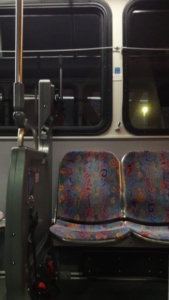
Every morning I try to leave my kitchen at 8:43. By the time my scarf is secured around my neck, my bag is over my shoulder and the front door is locked behind me, it’s 8:47. It takes about 90 seconds to walk through the alley to the bus stop, giving me just enough time to get my bus pass out of my wallet so I can be ready for my 8:51 pick up.
My office offers employees an option between a monthly parking pass or bus pass, and after a week of timed trials and experimentation, I decided to opt for the bus pass. I determined that the sacrifice in morning flexibility would be worth the money I could save on gas.
(I recognize that there is real privilege in this choice; mobility is a privilege, and I am lucky to have options for my commute.)
More than reducing my gas budget, taking the bus has given me a new way to see Detroit. I have a chance to look out the window and notice the sorts of details in my surroundings that would otherwise be lost in the fog of traffic induced impatience.
What’s more, my commute has given me a new lens to reflect on the legacy of segregation and suburbanization in our metro region.

Standing and waiting for the bus in the morning, it’s hard to ignore the way decades of white flight and suburbanization manifest themselves in the heavy one-way traffic of (mostly white) commuters on Jefferson in the morning coming in from the suburbs.
It’s just as hard to ignore that I am often the only white passenger on my bus—the conspicuousness of my whiteness forces me to think hard about where I can and ought to fit into the city.
I’m grateful for my commute because it’s given me another lens to see the city and its complex history. I don’t know if it’s given me any answers, but I do think that I’m asking better questions than I was before.
